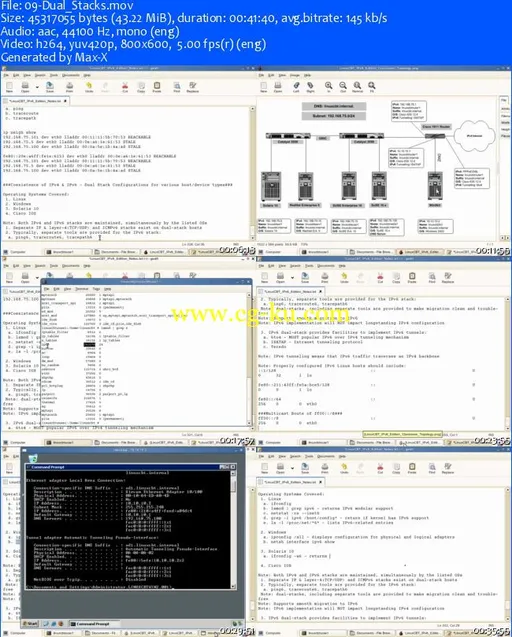
LinuxCBT IPv6 Edition
English | .MOV | h264, yuv420p, 800x600, 5.00 fps(r) | aac, 44100 Hz, mono | 1.12 GB
Genre: E-learning
Network - Visio Drawing - Topology Overview
Explore classroom environment
Discuss the protocols used
Identify key infrastructure devices
Explain network topology - Visio
Discuss the IPv4 RFC-1918 Intranet & DMZ configuration
Download and install NMap IPv4/IPv6 network scanning utility
Query Intranet hosts using NMap
Open Systems Interconnect (OSI) & TCP/IP|DOD Networking Models
Discuss the OSI model
Identify key IP-related services at various layers of the OSI model
Explain Protocol Data Unit (PDU) framing at various OSI levels
Discuss the DOD model
Correlate TCP/IP|DOD model to the OSI model
Identify and discuss key IPv4 layers of both networking models
Identify and discuss key IPv6 layers of both networking models
IPv4 Features & Limitations
Discuss the history of IPv4
Explain the flow of traffic in a typical IPv4 environment
Explain IPv4 multiplexing
Discuss Network Address Translation (NAT)
Discuss classful and classless IPv4 addresses
Explain the role subnet masks play in network delineation
Discuss Address Resolution Protocol (ARP)
Discuss IPv4 Internet Control Messaging Protocol (ICMP)
Decode OSI layers (2-7) using 'tcpdump' packet sniffer/logger
IPv6 Features
Discuss the expanded bit-range used to define source/destination IPv6 addresses
Explain the hierarchial nature of IPv6 prefixes
Discuss the typical /48 organizational globally-unique prefix
Explain typical ISP prefix assignments
Discuss minimum Message Transfer Units (MTUs)
Discuss automatic configuration of IPv6-enabled hosts - local|router|DHCP
Explain NAT & ARP obsolescence in an IPv6 environment
Discuss primary IPv6 address types - Unicast|Multicast|Anycast
Describe the role multicast plays in solicitations/advertisments & reduced congestion
Explain how layer-4 protocols (TCP/UDP) are implemented
Identify Hexadecimal address representation
Hexadecimal Conversions
Analyze and discuss typical link local address auto-configured by IPv6
Discuss the range of HEX characters
Compare and contrast the boundaries of IPv6 and IPv4 addresses
Explain some of the caveats of using decimal to represent IPv6 addresses
Compare and contrast HEX and decimal character ranges
Outline the rules for converting from decimal to HEX
Translate decimal values to HEX
Translate IPv4 broadcast address to HEX
Convert IPv4 publicly routable address to a 6-to-4 IPv6 address
Outline the rules for converting from HEX to decimal
Translate HEX nibbles to decimal equivalent
IPv6 Addressing - Colon Hexadecimal Notation
List key IPv6 address rules
Expand a 6-to-4 globally-unique IPv6 address to its full 128-bit representation
Segment the 6-to-4 globally-unique IPv6 address into key sections
Discuss the key sections of 6-to-4 IPv6 address with respect to routing and host identification
Explain the rules and benefits of using Zero-compression with IPv6 addresses
Identify unique IPv6 addresses and correlate to IPv4 - i.e. Loopback/Socket
Identify and discuss 48-bit MAC addresses
Explain the significance of MAC addresses in forming unique EUI-64 IPv6 addresses
Discuss link local address limitations
Identify key IPv6 sockets
Use 'ping6' and 'ICMPv6' to communicate with various IPv6 addresses
Identify the number of bits available for subnets and hosts
IPv6 Header
Discuss the benefits of a concise, fixed-length header
Identify the characteristics of key IPv6 header fields
Compare and contrast IPv4 and IPv6 headers
Explain the benefits of extension headers
Discuss how fragmentation is handled in IPv6
ICMPv6 - Header & Applications
Define ICMP
Explain ICMPv6 applications
Discuss ICMPv6 Neighbor Discovery (ND)
Compare & contrast Neighbor Discovery to Address Resolutipn Protocol (ARP)
List examples of ICMPv4 and ICMPv6 debugging utilities
Explain levels of ICMPv6 messages
Discuss important ICMPv6 error messages
Compare and contrast ICMPv4 and ICMPv6 headers
Use 'tcpdump' to decode ICMPv6 - Neighbor/Router Discoveries/Solicitations
Explore ICMPv6's usage of multicast IPv6 addresses
Discuss the role of Duplicate Address Detection (DAD) in IPv6 address conflict resolution
Explain and explore neighbor tables
Install RDesktop - RDP - Terminal Services client
Connect to Windows Host in DMZ and attempt to communicate using Link Local IPv6 address
Dual Protocol (IPv4 & IPv6) Stacks
Discuss the pros and cons of dual protocol stacks
Identify the independent stacks at various OSI layers
Identify distinct IPv4 and IPv6 tools
Enumerate and discuss the supported tunneling mechanisms in a dual-stack environment
Explore default IPv4 and IPv6 routing tables
Identify key unicast and multicast routing entries
Explore IPv6 stacks on Linux | Windows | Solaris
Common IPv6 Prefixes/Subnets
Define IPv6 Prefixes/Subnets
Compare and contrast IPv4 subnets with IPv6 prefixes
Identify key prefixes - loopback, link local, site local, ISP, ISP-assigned /48, /64 Unique Host
Discuss how router configuration and advertisments influence host configuration
Discuss multicast prefixes
More Info
